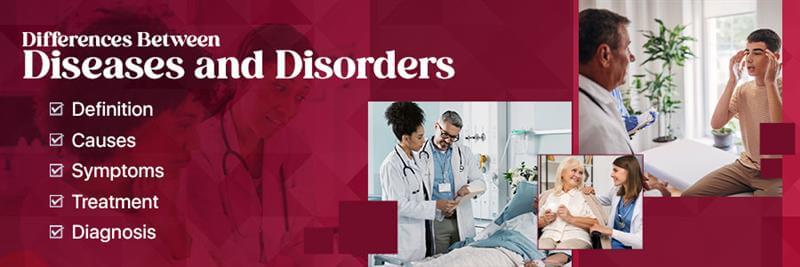To schedule an appointment call: 1 (800) 605-0031
To schedule an appointment call: 1 (800) 605-0031

In the world of healthcare, disease and disorder are often used interchangeably. This leads to confusion among patients and even healthcare professionals. Then, what is the difference between a disease and a disorder? Both terms describe a condition affecting an individual’s health, but they have distinct differences in terms of definitions, causes, symptoms, and treatments.
In this blog, we will take you through the differences between diseases and disorders to help you understand and navigate the healthcare system more effectively.
A disease can be described as a pathological condition that affects the normal functioning of the body’s organs, tissues, or symptoms. Causes generally include infections, genetic mutations, environmental factors, or a combination of these. Diseases can be chronic or acute, which means they can either develop slowly over time or have a sudden onset. Some examples of diseases include cancer, diabetes, heart disease, Parkinson’s disease, etc.
Medical professionals categorize the causes of a disease into two major categories: genetic and environmental. A genetic disease results from deviations or abnormalities in the genes inherited from parents. Examples of genetic diseases include Huntington’s disease, cystic fibrosis, and sickle cell anemia. Conversely, environmental diseases are caused by exposure to external factors like pollution, toxins, or radiation. Environmental diseases include skin cancer caused by sun exposure, lung cancer caused by smoking, and lead poisoning caused by exposure to lead-based products.
Symptoms of a disease can vary depending on the type and severity of the condition. Common symptoms of diseases include pain, fever, nausea, fatigue, vomiting, and difficulty breathing. Treatment options for diseases depend on the specific situation and may include surgery, medication, chemotherapy, radiation therapy, or lifestyle changes, such as diet and exercise.
A disorder can be defined as a functional anomaly or disruption that affects an individual’s mental and physical well-being. It can affect a person’s ability to perform daily activities, socialize, or maintain relationships. As opposed to diseases, disorders do not always have a clear underlying cause and may result from genetic and environmental factors. Disorders can be categorized into different types based on their nature and the affected body system. A few common disorders include anxiety disorders, mood disorders, personality disorders, sleep disorders, and neurodevelopmental disorders, such as autism.
What is the difference between a disease and a disorder? To understand the answer, you need to know the causes and symptoms of disorders, just like you now know the same about diseases. The causes of a disorder are usually complex and can involve genetic, environmental, and psychological factors. In specific conditions like bipolar disorder and schizophrenia, genetic factors might play a role. Still, environmental factors like trauma and stress can also contribute to developing these conditions. The development of disorders can also include psychological factors like coping mechanisms and personality traits. The symptoms can vary depending on the specific condition and can affect a person’s mental or physical health. Common symptoms of disorders include anxiety, mood changes, depression, hallucinations, insomnia, and difficulty concentrating. The management of disorders frequently entails a combination of pharmacotherapy, psychotherapeutic interventions, and lifestyle modifications, including stress reduction techniques and physical activity.

A thyroid eye disease doctor near me might not be the best choice for treating anxiety. That is where the differences between diseases and disorders originate. Let’s take a look at some of those differences.
A disease is a pathological condition affecting the regular functioning of the body’s tissues, organs, or systems, while a disorder is a functional abnormality or disruption that affects an individual’s mental or physical health.
Diseases can be caused by genetic or environmental factors or an interplay of both, whereas disorders can also be caused by genetic and environmental factors and psychological factors, such as a person’s personality and coping mechanisms.
The symptoms of a disease may include fever, pain, nausea, fatigue, vomiting, and difficulty breathing, while symptoms of disorders can include anxiety, mood changes, insomnia, depression, hallucinations, and difficulty concentrating.
Treatment options for diseases and disorders are not the same. For diseases, doctors may prescribe medication, surgery, chemotherapy, radiation therapy, and lifestyle changes like diet and exercise. In most instances, the objective of treatment is to cure the disease or keep its symptoms in check to improve the patient’s quality of life. The purpose of therapy is to manage the symptoms of the ailment and enhance an individual’s capacity to perform daily tasks.
One more critical difference between diseases and disorders arises from the way they are diagnosed. Diseases are usually diagnosed through medical imaging, lab tests, and physical exams, whereas disorders may require a more in-depth evaluation of a person’s mental and emotional state.
Now, there are a few conditions that can be classified as a disease and a disorder. For example, Parkinson’s disease affects the brain and nervous system but may also have psychological implications, causing symptoms like anxiety and depression. As you can see, Parkinson’s disease is a condition that can be called a disease, as well as a disorder.
Numerous diseases and disorders affect people worldwide. Here are some of the most common types.
• Infectious Diseases: These are caused by pathogens like viruses, bacteria, parasites, and fungi. Examples include the common cold, flu, pneumonia, HIV/AIDS, and tuberculosis.
• Chronic Diseases: These are persistent conditions that take a long time to develop. Examples include diabetes, heart disease, cancer, and stroke.
• Autoimmune Diseases: When the immune system mistakenly targets and attacks the cells and tissues of the body, it results in autoimmune diseases. Examples include lupus, rheumatoid arthritis, and multiple sclerosis.
• Inherited Diseases: These are diseases caused by genetic mutations from parents. Examples include sickle cell anemia, cystic fibrosis, and Huntington’s disease.
• Degenerative Diseases: These cause a gradual decline in the function or structure of the affected tissue or organ. Examples include Parkinson’s disease, Alzheimer’s disease, and osteoporosis.
• Mental Health Disorders: These affect a person’s mood, behavior, and thinking process. Examples include anxiety, depression, schizophrenia, bipolar disorder, and obsessive-compulsive disorder.
• Neurodevelopmental Disorders: These disorders affect the nervous system and brain development. Examples include attention deficit/hyperactivity disorder (ADHD), autism spectrum disorder, and intellectual disability.
• Sleep Disorders: These affect an individual’s ability to sleep properly. Examples include insomnia, sleep apnea, and restless leg syndrome.
• Eating Disorders: These affect a person’s relationship with food and body image. Examples comprise anorexia nervosa, bulimia nervosa, and binge-eating disorder.
• Substance Use Disorders: These arise when someone becomes dependent on drugs or alcohol. Examples include alcoholism, opioid addiction, and cocaine addiction.
So, what is the difference between a disease and a disorder? If you have been with us since the beginning, you know that the terms disease and disorder are often used interchangeably despite having distinct differences. Diseases are pathological, affecting the normal functioning of the organs, tissues, or systems. Disorders are functional abnormalities or disturbances affecting an individual’s mental or physical health.
When you know the differences between these two terms, you can help yourself or your loved ones get the correct diagnosis and treatment at the Samaritana Medical Clinic. Hundreds of diseases and disorders affect people around the world, and it is of the utmost importance to consult a healthcare professional if there are any concerns regarding their well-being or if they are experiencing any symptoms.
Proper care and management are often what it takes to effectively treat or manage diseases and disorders, improving the patient’s quality of life.
Must Read: Do Kidney Stones Cause Urinary Tract Infections?
Yes, some disorders, if left unmanaged, may develop into more severe pathological conditions. For instance, chronic stress (a disorder) may lead to heart disease or gastrointestinal issues over time.
Not necessarily. Some disorders, like severe depression or schizophrenia, can be life-threatening, while certain diseases, such as mild infections, may resolve easily. Severity depends on the condition, not the label.
A3. Usually not. Most disorders, especially mental health-related, are diagnosed through psychological evaluations rather than lab tests. Diseases are more likely to present measurable biomarkers in blood or imaging.
Yes, some conditions like Parkinson’s can be classified as both. It’s a neurological disease with pathological changes, but it also leads to functional impairments typical of a disorder.
Often, yes. Disorders like ADHD, anxiety, and autism are more commonly diagnosed in children and adolescents, while many chronic diseases are more prevalent in older populations due to aging.